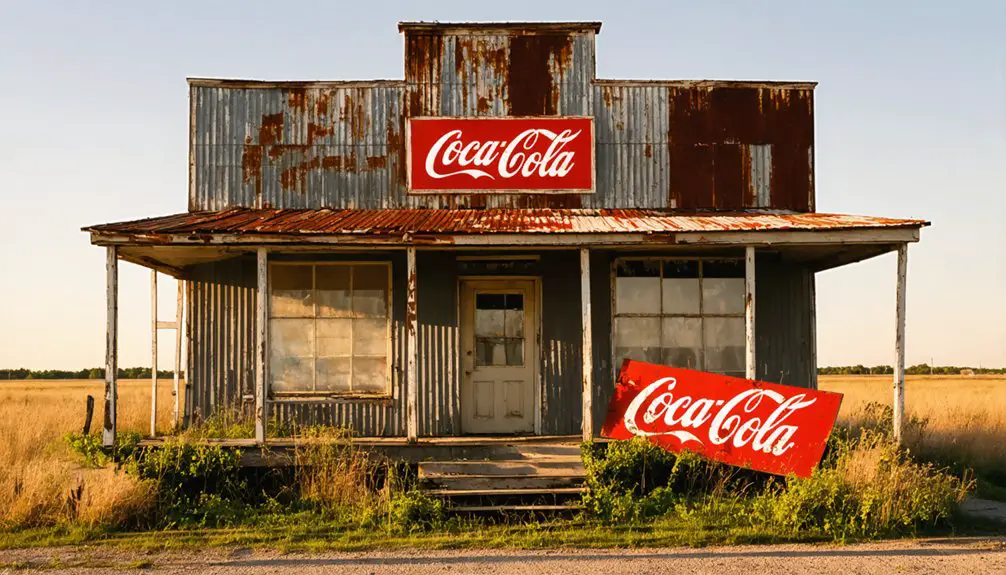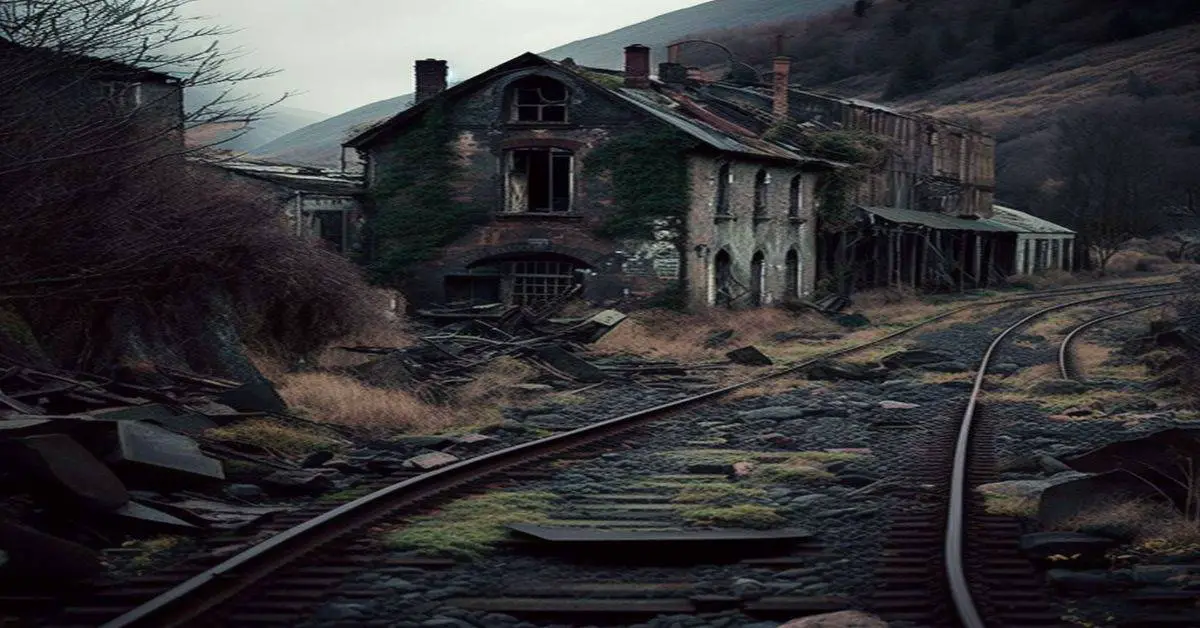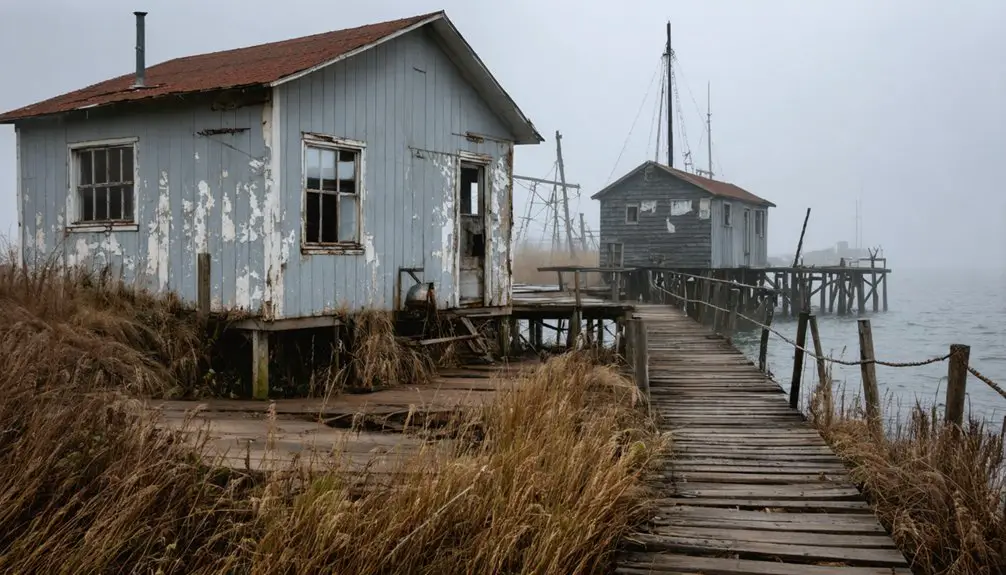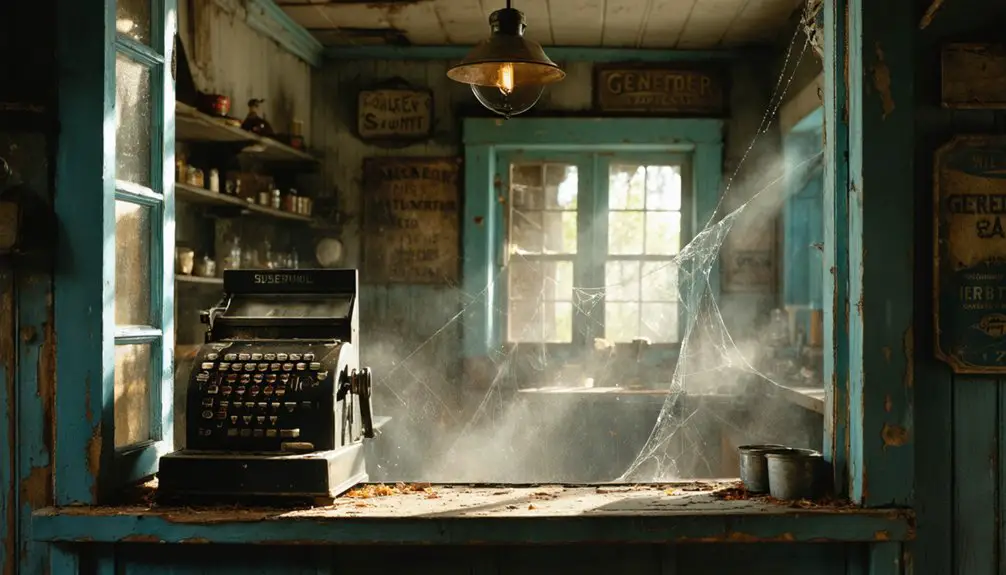You’ll find Dell Prairie’s remnants partially submerged beneath Castle Rock Lake, where pioneer families first settled in 1849. The community, led by Thomas Rich and other settlers, initially thrived with 100 small farms, a schoolhouse, and Baptist church. During the Great Depression, large agricultural corporations bought out family farms, transforming Dell Prairie into a bedroom community. Beyond the lake’s waters lie architectural ruins, mysterious tales, and historical records that reveal this ghost town’s fascinating transformation.
Key Takeaways
- Dell Prairie transformed from a thriving 1850s settlement of 100 family farms into a ghost town through systematic buyouts by large agricultural corporations.
- The Great Depression accelerated Dell Prairie’s decline, causing property values to plummet and forcing local businesses to close permanently.
- Parts of the original Dell Prairie settlement now lie submerged beneath Castle Rock Lake, including the historic Dover Drive hotel’s foundation.
- Abandoned buildings throughout Dell Prairie became subjects of ghost stories, with reports of mysterious fires, apparitions, and unexplained deaths.
- Architectural remnants include scattered building materials, partial foundations, and cellar holes from former inns and commercial establishments.
The Rise of a Wisconsin Settlement
The settlement of Dell Prairie began in earnest during the fall of 1849 and spring of 1850, when pioneering families including Thomas Rich, William Davis, Holland Carter, George Knox, Cotterel, and Mathews arrived in this unsurveyed portion of Adams County, Wisconsin.
You’d find these early settler experiences marked by fierce determination to protect their claims. They formed a “Claim Protection Society” to defend their land rights before official surveying began in 1851. The area they settled straddled the terminal moraine, creating distinct soil conditions for farming on either side.
Once the surveys were complete, you could’ve witnessed a rush of 45 men in a single day at the Mineral Point land office, enthusiastic to secure their legal titles.
The community’s spirit of cooperation showed in their shared boarding costs and children’s education arrangements. They even pooled resources to provide transportation for their religious leader, ensuring essential services reached their growing settlement. The community’s commitment to education was evident when Thomas Rich constructed the first schoolhouse in Adams County in 1850.
Life in Early Dell Prairie
Daily routines in Dell Prairie revolved around the harsh realities of frontier life during the early 1850s.
You’d find settlers banding together in clubs to protect their land claims, facing pioneer hardships like dangerous well-digging – which claimed the life of settler Horton in 1850.
Community resilience showed through organized religious life at the Baptist church, where Rev. C.L. Fisher led services after 1854.
The Baptist church and Rev. Fisher’s leadership in 1854 demonstrated how faith bound Dell Prairie’s frontier community together.
The 1850 census recorded just 187 residents spread across Dell Prairie and New Haven.
In your daily life, you’d have encountered wildlife, including lynx, while clearing land for farming.
The post office served as your connection to the outside world, and you’d participate in annual town officer elections after 1855.
Living among fellow settlers in emerging villages like Preston, Fordham, and Big Springs, you’d find strength in the close-knit community structure.
Economic Forces Behind the Decline
While small farms initially thrived in Dell Prairie with roughly 100 family-owned operations, large agricultural conglomerates gradually acquired these properties through systematic buyouts.
These economic shifts devastated the town’s commercial foundation as the farming population dwindled, forcing local businesses to close their doors.
Much like Dellwood’s decline after the stock market crash, property values plummeted and many owners lost their land.
Today, Dell Prairie mirrors the fate of towns like Almond that transformed from farming communities into bedroom communities, with most residents commuting elsewhere for work.
The agricultural consolidation coincided with dramatic changes in transportation. As railroads gave way to automobiles, you’d see fewer travelers stopping in Dell Prairie.
New highways made it easier for residents to shop in larger towns, while the loss of rail service isolated the community from crucial markets.
The Great Depression delivered another blow, and unlike neighboring communities that reinvented themselves as resort towns, Dell Prairie couldn’t adapt.
Without industrial investment or tourism development, the town’s economy continued its steady decline.
Dark Tales and Local Legends
- Mysterious fires, ghostly apparitions, and shadowy figures haunted abandoned buildings, especially near Dellwood Pavilion.
- Unexplained deaths, disappearances, and violent crimes left a lasting imprint on the community’s psyche.
- Recurring epidemics and plagues decimated the population without medical explanation. Like many Wisconsin settlements, the spread of deadly malaria devastated families and drove survivors away from the area.
- Wood-frame structures dominated early construction, including the 1883 mill adjacent to the dam.
- Alluvial clay deposits enabled local brick manufacturing for later industrial buildings.
- Early buildings featured modest elements like single small windows, reflecting pioneer craftsmanship.
- Waters carved deep sandstone canyons and created steep-sided bluffs
- Flood events stripped away glacial deposits, exposing unique rock formations
- New microhabitats emerged, supporting diverse plant and animal communities
- The Harry Ellsworth Cole papers (1837-1929), featuring significant photographic evidence of local structures
- Census records revealing population patterns, including the notable 1890 Veterans Census
- Critical records tracking births, deaths, and marriages of former residents
- No tourist infrastructure exists, with limited accessibility and minimal signage
- The original settlement area has mostly reverted to rural landscape
- Archaeological potential remains largely unexplored, with possible hidden foundations beneath vegetation
- https://www.youtube.com/watch?v=Lr3PYbaeL0k
- https://adamshistory.com/?page_id=1351
- https://en.wikipedia.org/wiki/Wisconsin_Dells
- https://www.wisconsinhistory.org/Records/Image/IM35083
- https://en.wikipedia.org/wiki/List_of_ghost_towns_in_Wisconsin
- https://www.formycousins.com/1878/1878atlas-Adams.html
- https://louisbluff.com/Louis’ Bluff – The Story of a Wisconsin Dells Landmark.html
- https://www.newhavenwi.us/history.html
- https://www.newhavenwi.us/uploads/2/1/8/8/21886640/early_new_haven_and_big_spring_compressed__1_.pdf
- https://www.newhavenwi.us/uploads/2/1/8/8/21886640/1878histatlaswisc.pdf
The town’s sinister reputation persists through generations of ghost stories, with some former residents fleeing not just poverty, but fear of dark spiritual forces that seemed to curse this once-thriving community. The discovery of Sarah Smith in Rosedale Cemetery revealed the horrifying reality of being buried alive, further fueling local fears of supernatural forces at work.
Architectural Legacy and Lost Structures
If you’re exploring Dell Prairie’s architectural remains today, you’ll find traces of pioneer ingenuity in the locally sourced timber and brick that once defined the town’s buildings.
The abandoned Dover Drive hotel’s foundation, now submerged beneath Castle Rock Lake, represents one of the area’s most significant structural losses.
While many original structures have vanished, scattered building materials and partial foundations hint at the practical, modest construction methods that characterized this late 19th and early 20th-century Midwestern settlement.
Like many ghost towns, Dell Prairie’s decline was largely due to changes in transportation routes that diverted traffic and commerce away from the once-thriving settlement.
Located near Wisconsin Dells, Dell Prairie’s ruins offer a glimpse into the region’s rich historical development.
Pioneer Building Materials
The architectural legacy of Dell Prairie’s pioneer era relied heavily on locally sourced materials, particularly timber harvested from the region’s abundant white, burr, and black oak trees, as well as soft maple and poplar found along streams and lower flats.
This timber sourcing shaped the material culture of early Dell Prairie, from log transport systems to wooden parts for logging sleds. The Chippewa River dam supported the booming lumber industry that defined the region’s early development.
The shift from wood to brick marked Dell Prairie’s evolution, as seen in the 1894 Dells Paper and Pulp Company mill.
While many original wooden structures haven’t survived, they’ve left an indelible mark on the town’s architectural heritage.
Abandoned Inn Remnants
Scattered remnants of Dell Prairie’s once-thriving inns dot the Wisconsin landscape, offering glimpses into the town’s bustling pioneer hospitality.
You’ll find stone foundations and cellar holes where these wooden structures once stood, though they’re often hidden beneath years of overgrowth. The inns’ historical significance is evident in their thoughtful construction, with locally quarried stone foundations and practical designs that suited the region’s available timber.
While inn restoration efforts face challenges due to the fragmentary nature of these sites, you can still discover traces of outbuildings, including wine cellars and storage sheds.
These architectural remnants tell the story of early Wisconsin commerce, when weary travelers found refuge in these humble establishments, complete with attached stables and small breweries that served their patrons.
Environmental Changes and Impact
When Castle Rock Lake reservoir was created, you’d find the rising waters submerging portions of the original Dell Prairie settlement and fundamentally altering the region’s hydrology.
The transformation from dense virgin forest to farmland, and later to a partially submerged landscape, has dramatically reshaped the area’s ecological systems.
You can now observe how the reservoir’s formation, covering 3.69% of Dell Prairie’s total area, has created new aquatic habitats while permanently altering the previous terrestrial environment.
Lake Formation Impact
During the Late Pleistocene epoch, approximately 15,000 years ago, massive glacial forces created Lake Wisconsin when an ice dam blocked the Wisconsin River near present-day Lake Delton.
You’ll find evidence of this ancient lake’s dramatic impact on Dell Prairie’s landscape, as the lake drainage transformed the region through powerful floods and erosion.
When the ice dam melted around 14,000 years ago, the ecological consequences reshaped the entire area:
The lake’s presence and subsequent drainage didn’t just alter the physical landscape – it established the Wisconsin River’s modern course and created distinct environmental zones that continue to influence local ecosystems today.
Natural Landscape Transformation
Throughout the past century, Dell Prairie’s natural landscape has undergone dramatic transformations that reach far beyond the ancient lake’s geological impact.
You’ll find the once-vast prairies, rich with native plants and wildlife, have given way to agricultural fields and altered watersheds. The area’s natural habitat has suffered from reduced fire frequency, leading to brush encroachment and invasive species taking hold.
The changes haven’t just affected the land – they’ve disrupted species migration patterns and reduced populations of prairie chickens and sandhill cranes.
The rich clayey soil that once supported diverse prairie ecosystems now primarily grows crops, while the streams that powered early mills bear lasting impacts from industrial use.
The transformation of wetlands and riparian zones has fundamentally altered the ecological processes that sustained Dell Prairie’s unique biodiversity for centuries.
Historical Documentation and Records
As researchers explore Dell Prairie’s past, a wealth of historical documentation provides essential insights into this Adams County ghost town. Through archival research and historical preservation efforts, you’ll find extensive records at the Wisconsin Historical Society Archives in Madison that paint a vivid picture of this vanished community.
Key documentation includes:
The Dell House, built in 1828 by Robert Allen and photographed in 1910, serves as a prime example of documented structures that once stood at coordinates 43°40’02″N 89°42’55″W before burning down prior to 1930.
Connection to Wisconsin Dells Tourism
While Wisconsin Dells transformed into the Midwest’s premier tourist destination in the mid-1800s, Dell Prairie maintained its distinct identity separate from the bustling waterpark capital.
You’ll find no direct tourism overlap between these geographically separate locations – Wisconsin Dells lies in Columbia and Sauk counties, while Dell Prairie sits in Lincoln County.
If you’re seeking an alternative to Wisconsin Dells’ commercialized attractions, Dell Prairie offers quieter scenic exploration opportunities at the Prairie Dells Scenic Area.
Here, you can discover river gorges and rock outcroppings without the crowds.
While Wisconsin Dells flourished with Leroy Gates’ boat tours and H.H. Bennett’s photography promotions, Dell Prairie’s ghost town status appeals to history enthusiasts looking for a more authentic, untouched experience in Wisconsin’s natural landscape.
Modern Day Ghost Town Status
Today, Dell Prairie stands as a true ghost town in Adams County, Wisconsin, with virtually no remaining structures and zero permanent residents.
The site exhibits classic ghost town characteristics, having been reclaimed by nature and agricultural development over time. You’ll find its cultural significance largely confined to historical records and ghost town listings rather than active preservation efforts.
If you’re planning to explore Dell Prairie, be aware of these key aspects:
The ghost town’s current state reflects the broader pattern of abandoned settlements in Wisconsin, serving primarily as a historical reference point rather than an active cultural site.
Frequently Asked Questions
Are There Any Remaining Accessible Structures or Ruins in Dell Prairie Today?
You won’t find accessible ruins or ghost stories to explore today – the site’s completely reverted to natural landscape with no verified standing structures or documented remains to visit.
What Native American Tribes Originally Inhabited the Dell Prairie Area?
You’ll find the richest Native tribes’ cultural heritage in the Ho-Chunk Nation, who dominated these lands first, followed by the Menominee and Chippewa peoples who shaped the region’s ancient landscape.
Did Any Famous Historical Figures Ever Visit or Stay in Dell Prairie?
You won’t find records of famous visitors in this area’s historical significance, as available documentation shows no concrete evidence of nationally recognized figures ever staying or passing through.
Were There Any Documented Murders or Unsolved Mysteries in Dell Prairie?
Picture a dusty archive of old newspapers – you won’t find clear records of specific murders or unsolved cases in Dell Prairie, though regional folklore hints at dark times and unexplained troubles.
How Many People Lived in Dell Prairie at Its Peak Population?
You’d find population decline stories but no exact peak numbers documented. While today’s town has around 1,600 residents, the historic ghost town’s maximum population remains a mystery lost to time.



